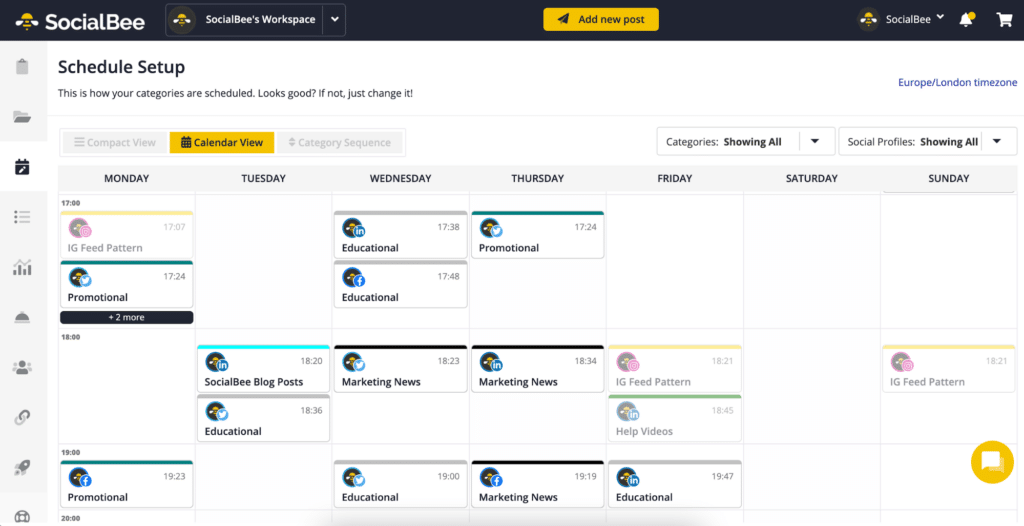
Content Manager at SocialBee
Why is learning how to write a case study so important?
Well, because it provides your customers with social proof and supporting evidence of how effective your products and services are. Moreover, it eliminates the doubt that usually makes clients give up on their next purchase.
That is why today we are going to talk about the step-by-step process of writing a case study. We prepared five business case study examples guaranteed to inspire you throughout the process.
Let’s get started!
What Is a Case Study?
A case study is a piece of content that focuses on a case from your business history. It describes the problems your client faced and the solutions you used to help them succeed.
The goal of a writing case study is to promote your business, so your aim should be to put together a compelling story with evidence that backs up all your claims.
Case studies use real-life examples to show your clients the quality and effectiveness of your products and services. It’s a marketing tool that provides credibility and it helps your potential clients gain confidence in your brand.
Case studies can be structured in different formats:
- A written document
- A video
- An infographic
- A blog post
- A landing page
Case Study Benefits
A great case study makes your potential customers want to benefit from the products and services that helped your client overcome their challenges.
Here are the benefits of writing a case study:
- It is an affordable marketing practice
- It decreases the perceived risk of your potential clients
- It provides transparency
- It builds trust and credibility among prospective customers
- It makes your potential clients relate to the problem
- It provides your potential clients with a solution for their problems
How to Write a Case Study
Now that you know what a case study is, let’s get into the real reason why you are here — learning how to write an in-depth study.
Here is the step-by-step process of writing a case study:
- Identify the topic of your case study
- Start collaborating with a client
- Prepare questions for the interview
- Conduct the case study interview
- Structure your case study
- Make it visual
Step 1: Identify the Topic of Your Case Study
A case study starts with a strategy. Choosing what you want to write about should be closely related to your business needs. More specifically, what service or product do you want to promote through your case study?
Because case studies focus on client challenges, business solutions, and results, you have to carefully pick the case that your potential clients will relate to the most.
To communicate the benefits of your business, you should focus on a customer story that appeals to a specific segment of your audience. Consequently, you will target clients that relate to your customer example while providing a solution for their needs and pain points — your products and services.
Start by focusing all your research methods on identifying your customers’ main pain points. Then find examples of how your products or services have helped them overcome their challenges and achieve their goals.
Furthermore, to make sure you choose the best case study topic for your buyer persona, you should have a meeting with your sales/customer service team. Because they are in close contact with your customers, they will be able to tell you:
- The main challenges your clients face
- The services/products that bring them the best results
These are the main two pieces of information you want your case study to focus on.
Step 2: Start Collaborating with a Client
With a clear topic in mind, you have to find the best fit for your case study.
However, that is not all. First, you must obtain the client’s permission. After all, your business story is theirs too.
So, craft an email to provide your client with an overview of the case study. This will help them make a decision.
Your message should include:
- The case study format (video, written, etc.) and where it will be published (blog, landing page, etc.)
- The topic of the document
- The timeline of the process
- The information that will be included
- The benefits they get as a result of this collaboration (brand exposure, backlinks)
Additionally, you can offer to schedule a call or a meeting to answer all their questions and curiosities and provide a means for clear and open communication.
Once you receive a positive response from your client, you can continue with the next step of the process: the actual interview.
PRO TIP: A great way to ensure a smooth and safe collaboration between you and your client is to sign a legal release form before writing the case study. This will allow you to use their information and protect you from issues that may occur in the future. Moreover, if the client is not comfortable with revealing their identity, you can always offer them anonymity.
Step 3: Prepare Questions for the Interview
Now that you have the subject for your case study, it’s time to write and organize your interview in several sets of questions.
Don’t forget that the whole structure of your case study is based on the information you get from your customer interview.
So pay attention to the way you phrase the questions. After all, your goal is to gather all the data you need to avoid creating a back-and-forth process that will consume your client’s time and energy.
To help you create the best questionnaire, we created a set of case study questions and organized them into different categories.
Here are the five main sections your case study interview should contain:
- The client’s background information
- The problem
- The start of the collaboration
- The solution
- The results
A. The Client’s Background Information
This part of the case study interview must give a comprehensive look into your customer’s business and allow your readers to get to know them better.
Here are some question ideas:
|
B. The Problem
Now it’s time to get into the reason your client came to you for assistance, the initial challenge that triggered your collaboration.
In this part of the interview process, you want to find out what made them ask for help and what was their situation before working with you.
You can ask your client the following case study questions:
|
C. The Start of the Collaboration
This part of the case study interview will focus on the process that made your collaboration possible. More specifically, how did your client research possible collaboration opportunities, and why they chose your business?
This information will not only be informative for your future customers but will also give you a behind-the-scenes look into their decision-making process.
Here are some question ideas:
|
D. The Solution
It’s time to get into one of the most significant parts of the case study interview — the solution. Here you should discuss how your services have helped their business recover from the problems mentioned before.
Make sure you ask the right questions so you can really paint the picture of a satisfied customer.
Have a look at these question examples:
|
E. The Results
The best proof you can give to your customers is through your results. And this is the perfect opportunity to let your actions speak for themselves.
Unlike the other marketing strategies you use to promote your business, the content is provided by your customer, not by your team. As a result, you end up with a project that is on another level of reliability.
Here is how you can ask your client about their results:
|
Step 4: Conduct the Case Study Interview
Now that you have a great set of case study questions, it’s time to put them to good use.
Decide on the type of interview you want to conduct: face-to-face, video call, or phone call. Then, consult with your client and set up a date and a time when you are both available.
It should be noted that during the interview it’s best to use a recording device for accuracy. Maybe you don’t have time to write down all the information, and you forget important details. Or maybe you want to be focused more on the conversational aspect of the interview, and you don’t want to write anything down while it’s happening.
Step 5: Structure Your Case Study
The hard part is over. Now it’s time to organize all the information you gathered in an appealing format. Let’s have a look at what your case study should contain.
Here are the components of a case study:
- Engaging title
- Executive summary
- Client description
- Introduction to the problem
- The problem-solving process
- Progress and results
A. Engaging Title
Putting that much work into a project, it would be a shame not to do your best to attract more readers. So, take into consideration that you only have a few seconds to catch your audience’s attention.
You can also use a headline analyzer to evaluate the performance of your title.
The best case study titles contain:
- Relevant keywords
- Customer pain points
- The solution
- Clear result
B. Executive Summary
Your executive summary should include a thesis statement that sums up the main points of your case study. Therefore, it must be clear and concise. Moreover, to make your audience curious, you can add a statistic or a relevant piece of data that they might be interested in.
Here is what you should include in your executive summary:
- The business you are writing about (only if the clients wants to make themselves known)
- The issue
- The solution
- Relevant statistics
C. Client Description
Here is where you start to include the information you gained from your interview. Provide your readers with a clear picture of your client and create a context for your case study.
Take your client’s answers from the “Client Background” section of the interview and present them in a more appealing format.
D. Introduction to the Problem
In this section, use your client’s interview answers to write about the problem they were experiencing before working with you.
Remember to be specific because you want your audience to fully understand the situation and relate to it. At the end of the day, the goal of the case study is to show your potential customers why they should buy your services/products.
E. The Problem-Solving Process
Next, explain how your service/product helped your client overcome their problems. Moreover, let your readers know how and why your service/product worked in their case.
In this part of the case study, you should summarize:
- The strategy used to solve the problem of your customer
- The process of implementing the solution
F. Progress and Results
Tell your readers about what you and your client have achieved during your collaboration. Here you can include:
- Graphics about your progress
- Business objectives they have achieved
- Relevant metrics
Step 6: Make It Visual
To elevate the information you have written for your audience, you must make sure it’s appealing and easy to read. And a great way to achieve that is to use visuals that add value to your case study.
Here are some design elements that will make emphasize your text:
- Graphic symbols that guide the eye (arrows, bullet points, checkmarks, etc.)
- Charts, graphics, tables
- Relevant screenshots from business reports
- The colors and fonts of your brand
- Your logo
- Your client’s logo
Platforms like Canva can really come in handy while designing your case study. It’s easy to use and it has multiple free slide templates and graphics that save you time and money.
PRO TIP: Share Your Case Study Across All Marketing Channels
A case study is a perfect example of evergreen content that can be reshared endlessly on your social media channels.
Aside from helping you maintain a consistent posting schedule with ease, case study-related posts will increase your credibility and push leads toward the bottom of your marketing funnel. Other examples of social proof evergreen content are reviews, testimonials, and positive social media mentions.
To keep track of all your evergreen posts and have them scheduled on a continuous loop, use a social media tool like SocialBee.
Create evergreen content categories where all your posts get reposted regularly on your social media channels.
Start your 14-day trial today and start using SocialBee for free!
Aside from promoting your case study on social media, you can also feature it in your newsletter that you can create using email newsletter software, include it as a pop-up on your website, and even create a separate landing page dedicated to your customer study.

Share Your Case Study on Social Media with SocialBee!
Get to Writing Your Own Case Study
What do you think? Is writing a case study easier than you thought? We sure hope so.
Learning how to write a case study is a simple process once you understand the logical steps that go into it. So make sure you go over the guide a couple of times before you start documenting your customer success stories.
And remember that the goal of your case study is to attract more leads. Therefore you need to include tangible results and valuable details that will compel your audience to invest in your products and services.
Good luck!











 Customizable tone of voice
Customizable tone of voice  Several variations to choose from
Several variations to choose from  1,000 pre-made AI prompts
1,000 pre-made AI prompts